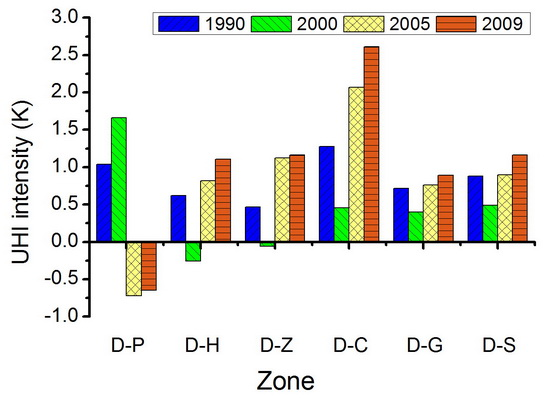The Impacts of Rapid Urbanization on the Thermal Environment: A Remote Sensing Study of Guangzhou, South China
Abstract
:1. Introduction
2. Study Area and Data
2.1. Study Area
2.2. Data Source
2.3. Image Preprocessing
3. Methods
3.1. Classification of Land Use and Land Cover
3.2. Calculation of NDVI and NDBI
3.3. Retrieval of Land Surface Temperature
- When NDVI > 0.70, ε = 0.99;
- When 0.05 ≤ NDVI ≤ 0.70, ε is computed using Equation (6).where Pv is the vegetation proportion obtained by Equation (7).
3.4. LST Normalization and UHI Intensity
4. Results and Discussions
4.1. Urban Expansion Analysis Based on Land Use/Cover Change
4.2. Spatiotemporal Variation in the Urban Thermal Environment
4.3. Impact of LULC on the Land Surface Temperature
4.3.1. Characteristics of Land Surface Temperature by LULC
4.3.2. UHI Intensity
4.3.3. Variation in the Regional Temperature Range
4.4. Correlation Analysis of LST and NDBI, NDVI
5. Conclusions
Acknowledgments
References
- Yue, W.; Xu, J.; Xu, L. An analysis on eco-environmental effect of urban land use based on remote sensing images: A case study of urban thermal environment and NDVI (in Chinese). Acta Ecol. Sin 2006, 26, 1450–1460. [Google Scholar]
- Chen, X.; Zhao, H.; Li, P.; Yin, Z. Remote sensing image-based analysis of the relationship between urban heat island and land use/cover changes. Remote Sens. Environ 2006, 104, 133–146. [Google Scholar]
- Kalnay, E.; Cai, M. Impact of urbanization and land-use change on climate. Nature 2003, 423, 528–531. [Google Scholar]
- Rosenzweig, C.; Karoly, D.; Vicarelli, M.; Neofotis, P.; Wu, Q.; Casassa, G.; Menzel, A.; Root, T.L.; Estrella, N.; Seguin, B.; Tryjanowski, P.; Liu, C.; Rawlins, S.; Imeson, A. Attributing physical and biological impacts to anthropogenic climate change. Nature 2008, 453, 353–357. [Google Scholar]
- Ye, H.; Wang, K.; Huang, S.; Chen, F.; Xiong, Y.; Zhao, X. Urbanisation effects on summer habitat comfort: A case study of three coastal cities in southeast China. Int. J. Sust. Dev. World 2010, 17, 317–323. [Google Scholar]
- Li, X.; Chen, F.; Ye, H.; Xiong, Y.; Shi, L.; Pan, L.; Wang, K. Trends of maximum temperature, minimum temperature and diurnal temperature range and their correlations with urbanisation in Xiamen, China. Int. J. Sust. Dev. World 2010, 17, 299–303. [Google Scholar]
- Owen, T.W.; Carlson, T.N.; Gillies, R.R. An assessment of satellite remotely sensed land cover parameters in quantitatively describing the climatic effect of urbanization. Int. J. Remote Sens 1998, 19, 1663–1681. [Google Scholar]
- Sheng, J.; Wilson, J.P.; Lee, S. Comparison of land surface temperature (LST) modeled with a spatially-distributed solar radiation model (SRAD) and remote sensing data. Environ. Model. Softw 2009, 24, 436–443. [Google Scholar]
- Weng, Q.; Quattrochi, D.A. Thermal remote sensing of urban areas: An introduction to the special issue. Remote Sens. Environ 2006, 104, 119–122. [Google Scholar]
- Wilson, J.S.; Clay, M.M.E.; Risch, K.V. Evaluating environmental influence of zoning in urban ecosystems with remote sensing. Remote Sens. Environ 2003, 86, 303–321. [Google Scholar]
- Zhang, Y.; Odeh, I.O.A.; Han, C. Bi-temporal characterization of land surface temperature in relation to impervious surface area, NDVI and NDBI, using a sub-pixel image analysis. Int. J. Appl. Earth Obs 2009, 11, 256–264. [Google Scholar]
- Jones, P.D.; Groisman, P.Y.; Coughlan, M.; Plummer, N.; Wang, W.; Karl, T.R. Assessment of urbanization effects in time series of surface air temperature over land. Nature 1990, 347, 169–172. [Google Scholar]
- Huang, S.; Taniguchi, M.; Yamano, M.; Wang, C. Detecting urbanization effects on surface and subsurface thermal environment—A case study of Osaka. Sci. Total Environ 2009, 407, 3142–3152. [Google Scholar]
- Voogt, J.A.; Oke, T.R. Thermal remote sensing of urban climates. Remote Sens. Environ 2003, 86, 370–384. [Google Scholar]
- Liu, L.; Zhang, Y. Urban heat island analysis using the Landsat TM data and ASTER data: A case study in Hong Kong. Remote Sens 2011, 3, 1535–1552. [Google Scholar]
- Fabrizi, R.; Bonafoni, S.; Biondi, R. Satellite and ground-based sensors for the urban heat island analysis in the City of Rome. Remote Sens 2010, 2, 1400–1415. [Google Scholar]
- Hamdi, R. Estimating urban heat island effects on the temperature series of Uccle (Brussels, Belgium) using remote sensing data and a land surface scheme. Remote Sens 2010, 2, 2773–2784. [Google Scholar]
- Rinner, C.; Hussain, M. Toronto’s urban heat island—Exploring the relationship between land use and surface temperature. Remote Sens 2011, 3, 1251–1265. [Google Scholar]
- Gong, A.; Chen, Y.; Li, J.; Hu, H. Study on relationship between urban heat island and urban land use and cover change in Beijing (in Chinese). Chin. J. Image Graph 2007, 12, 1476–1482. [Google Scholar]
- Tian, P.; Tian, G.; Wang, F.; Wang, Y. Urban heat island effect and vegetation cover index relation using Landsat TM image (in Chinese). B. Sci. Technol 2006, 22, 708–713. [Google Scholar]
- Weng, Q.; Lu, D.; Schubring, J. Estimation of land surface temperature-vegetation abundance relationship for urban heat island studies. Remote Sens. Environ 2004, 89, 467–483. [Google Scholar]
- Zhou, L.; Dickinson, R.E.; Tian, Y.; Fang, J.; Li, Q.; Kaufmann, R.K.; Tucker, C.J.; Myneni, R.B. Evidence for a significant urbanization effect on climate in China. Proc. Natl. Acad. Sci. USA 2004, 101, 9540–9544. [Google Scholar]
- Weng, Q. A remote sensing-GIS evaluation of urban expansion and its impact on surface temperature in the Zhujiang Delta, China. Int. J. Remote Sens 2001, 22, 1999–2014. [Google Scholar]
- Weng, Q.; Lu, D. A sub-pixel analysis of urbanization effect on land surface temperature and its interplay with impervious surface and vegetation coverage in Indianapolis, United States. Int. J. Appl. Earth Obs 2008, 10, 68–83. [Google Scholar]
- Yuan, F.; Bauer, M.E. Comparison of impervious surface area and normalized difference vegetation index as indicators of surface urban heat island effects in Landsat imagery. Remote Sens. Environ 2007, 106, 375–386. [Google Scholar]
- Ding, J.; Zhang, Z.; Xi, H.; Zhou, H. A study of the high temperature distribution and the heat island effect in the summer of the Shanghai area (in Chinese). Chin. J. Atmos. Sci 2002, 26, 412–420. [Google Scholar]
- Qian, L.; Ding, S. Influence of land cover change on land surface temperature in Zhujiang Delta (in Chinese). Acta Geogr. Sin 2005, 60, 761–770. [Google Scholar]
- Gallo, K.P.; McNAB, A.L.; Karl, T.R.; Brown, J.F.; Hood, J.J.; Tarpley, J.D. The use of a vegetation index for assessment of the urban heat island effect. Int. J. Remote Sens 1993, 14, 2223–2230. [Google Scholar]
- Chen, Y.; Shi, P.; Li, X.; He, C. Research on urban spatial thermal environment using remote sensing image—Fractal measurement of thermal field structure & its change (in Chinese). Acta Geod. Cartogr. Sin 2002, 31, 322–326. [Google Scholar]
- Chen, Y.; Sui, D.Z.; Fung, T.; Dou, W. Fractal analysis of the structure and dynamics of a satellite-detected urban heat island. Int. J. Remote Sens 2007, 28, 2359–2366. [Google Scholar]
- Yang, Y.; Su, W.; Jiang, N.; Zhen, F. Spatial-temporal characteristics of urban heat island effect change of Nanjing city and its relation with land use change (in Chinese). Geogr. Res 2007, 26, 877–886. [Google Scholar]
- Huang, R.; Xu, H. A study on the relationship between land cover/use and urban heat environment using Landsat ETM+ satellite imagery: A case study of Fuzhou (in Chinese). Remote Sens. Inf 2005, 2005, 36–39. [Google Scholar]
- Zha, Y.; Gao, J.; Ni, S. Use of normalized difference built-up index in automatically mapping urban areas from TM imagery. Int. J. Remote Sens 2003, 24, 583–594. [Google Scholar]
- Fan, S.; Dong, J.; Guo, L.; Wang, A.; Song, L.; Liu, A.; Xie, J. Analysis of the impact of urban growth on the temperature field in Guangzhou (in Chinese). J. Trop. Meteorol 2005, 21, 623–627. [Google Scholar]
- Feng, J.; Pan, A.D. Relationship between temperature transformation and urbanization development of Guangzhou (in Chinese). J. Guangzhou Univ. (Nat. Sci) 2011, 10, 89–94. [Google Scholar]
- Weng, Q. Fractal analysis of satellite-detected urban heat island effect. Photogramm. Eng. Remote Sensing 2003, 69, 555–566. [Google Scholar]
- Weng, Q.; Yang, S. Managing the adverse thermal effects of urban development in a densely populated Chinese city. J. Environ. Manage 2004, 70, 145–156. [Google Scholar]
- Jiang, X.; Xia, B.; Guo, L. Research on urban heat island and its environmental effects of rapidly urbanized regions (in Chinese). Ecol. Sci 2006, 25, 171–175. [Google Scholar]
- Zhao, L.; Zhao, Y.; Dong, G. Study on monitoring technique of urban heat island effect in Guangzhou based on ETM+ imagery (in Chinese). Environ. Monit. Chin 2006, 22, 59–63. [Google Scholar]
- Wang, F.; Zhuo, L.; Feng, Y. Spatial distribution of heat island in Guangzhou in summer and winter (in Chinese). Trop. Geogr 2007, 27, 198–202. [Google Scholar]
- Wen, X.; Hu, G.; Yang, X. The effect of vegetation cover change on urban heat island in Guangzhou using Landsat images (in Chinese). Ecol. Environ 2008, 17, 985–988. [Google Scholar]
- Ma, Y.; Kuang, Y.; Huang, N. Coupling urbanization analyses for studying urban thermal environment and its interplay with biophysical parameters based on TM/ETM+ imagery. Int. J. Appl. Earth Obs 2010, 12, 110–118. [Google Scholar]
- Zhang, J.; Wang, Y. Study of the relationships between the spatial extent of surface urban heat islands and urban characteristic factors based on Landsat ETM+ data. Sensors 2008, 8, 7453–7468. [Google Scholar]
- Fan, F.; Weng, Q.; Wang, Y. Land use and land cover change in Guangzhou, China, from 1998 to 2003, based on Landsat TM/ETM+ imagery. Sensors 2007, 7, 1323–1342. [Google Scholar]
- Lu, T. 2007 Guangzhou’s Numbers (in Chinese); Guangzhou Yearbook Press: Guangzhou, China, 2008. [Google Scholar]
- Pal, M.; Mather, P.M. An assessment of the effectiveness of decision tree methods for land cover classification. Remote Sens. Environ 2003, 86, 554–565. [Google Scholar]
- Purevdorj, T.S.; Tateishi, R.; Ishiyama, T.; Honda, Y. Relationships between percent vegetation cover and vegetation indices. Int. J. Remote Sens 1998, 19, 3519–3535. [Google Scholar]
- Landsat Project Science Office. In The Landsat-7 Science Data User’s Handbook; Goddard Space Flight Center, NASA: Greenbelt, MD, USA, 2008; p. 186. Available online: http://landsathandbook.gsfc.nasa.gov/pdfs/Landsat7_Handbook.pdf (accessed on 8 November 2011).
- Artis, D.A.; Carnahan, W.H. Survey of emissivity variability in thermography of urban areas. Remote Sens. Environ 1982, 12, 313–329. [Google Scholar]
- Markham, B.L.; Barker, J.K. Spectral characteristics of the LANDSAT Thematic Mapper sensors. Int. J. Remote Sens 1985, 6, 697–716. [Google Scholar]
- Qin, Z.H.; Li, W.J.; Xu, B.; Cheng, Z.X.; Liu, J. The estimation of land surface emissivity for Landsat TM6 (in Chinese). Remote Sens. Land Resour 2004. [Google Scholar]
- Sobrino, J.A.; Jiménez-Muñoz, J.C.; Paolini, L. Land surface temperature retrieval from LANDSAT TM 5. Remote Sens. Environ 2004, 90, 434–440. [Google Scholar]
- Liu, Y.; Kuang, Y.Q.; Wu, Z.F.; Huang, N.S.; Zhou, J. Impact of land use on urban land surface temperature—A case study of Dongguan, Guangdong Province (in Chinese). Sci. Geogr. Sin 2006, 26, 597–602. [Google Scholar]
- Xu, H.Q.; Chen, B.Q. Remote sensing of the urban heat island and its changes in Xiamen City of SE China. J. Environ. Sci 2004, 16, 276–281. [Google Scholar]
- Oke, T.R. Boundary Layer Climates, 2nd ed; Routledge: London, UK, 1988; p. 435. [Google Scholar]
- Lo, C.P.; Quattrochi, D.A.; Luvall, J.C. Application of high resolution thermal infrared remote sensing and GIS to assess the urban heat island effect. Int. J. Remote Sens 1997, 18, 287–303. [Google Scholar]
- Weng, Q.; Lu, D.; Liang, B. Urban surface biophysical descriptors and land surface temperature variations. Photogram. Eng. Remote Sensing 2006, 72, 1275–1286. [Google Scholar]
- Sun, Q.; Wu, Z.; Tan, J. The relationship between land surface temperature and land use/land cover in Guangzhou, China. Environ. Earth Sci 2012, 65, 1687–1694. [Google Scholar]
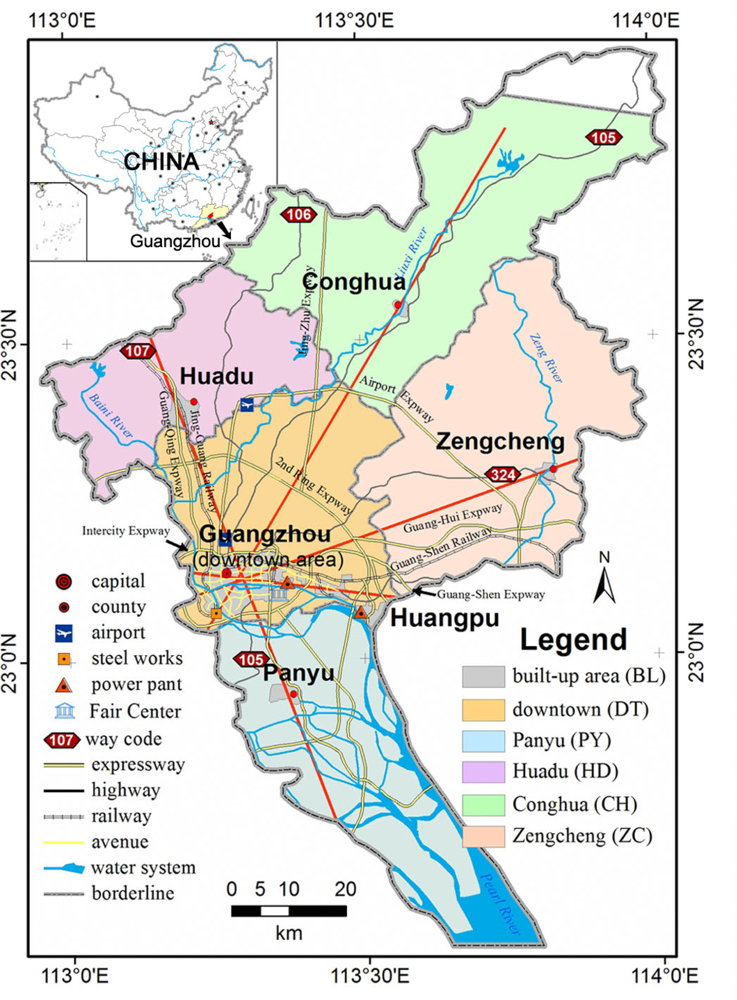
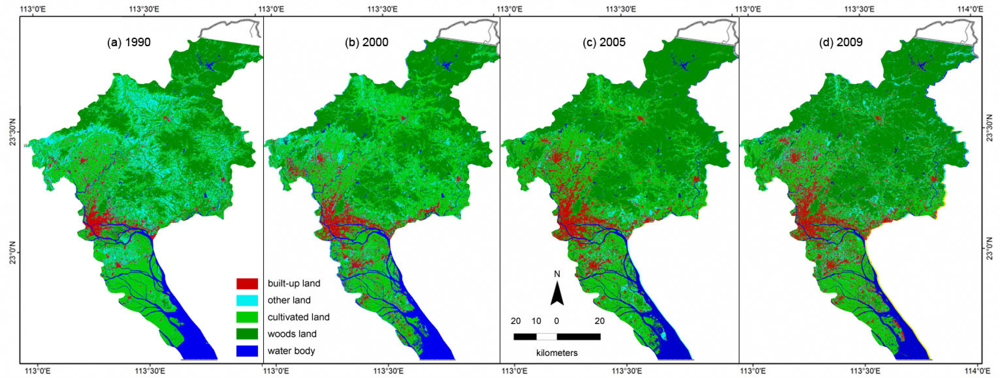

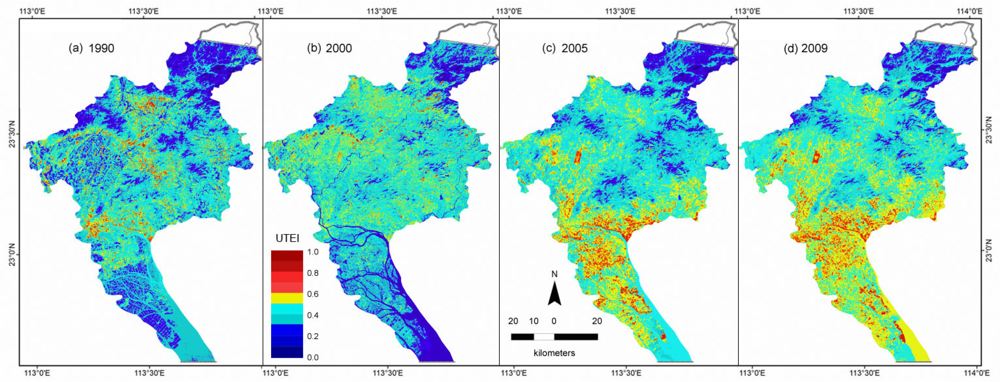

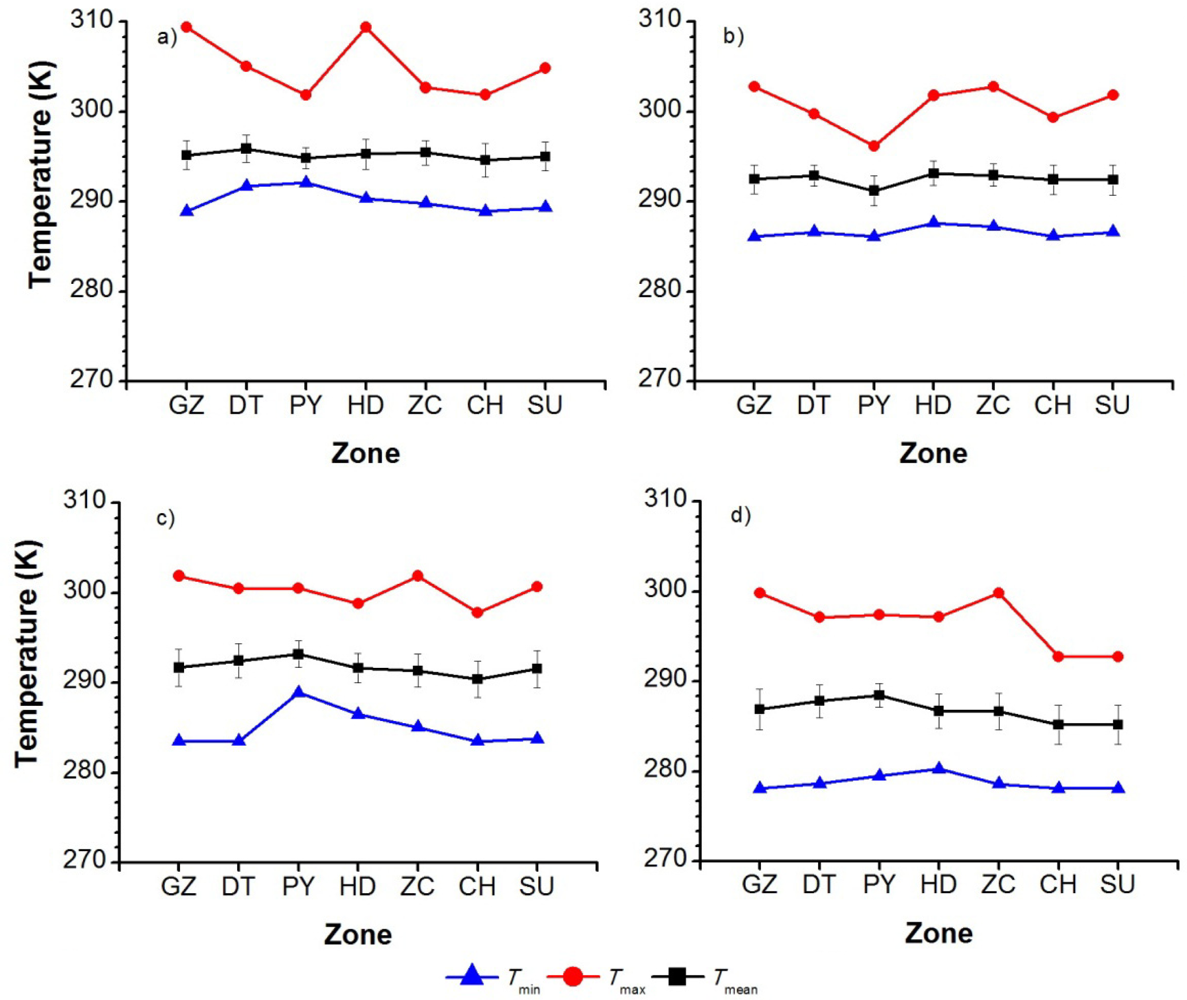

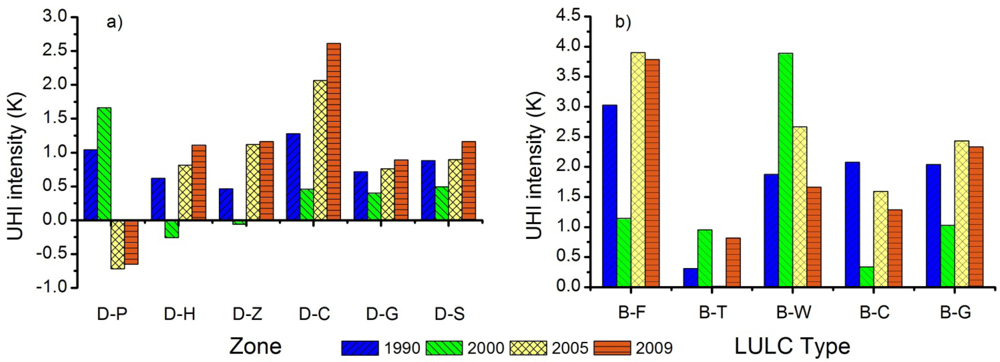
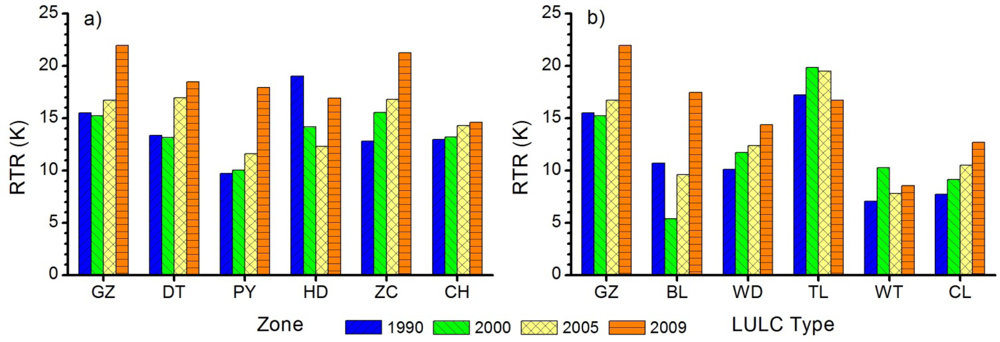

| Acquired Date | Sensor | Cloud (%) | Tmean (K) | Tmax (K) | Tmin (K) | DTR (K) | Prcp (mm) | Wmean (m/s) | Vmean (km) |
|---|---|---|---|---|---|---|---|---|---|
| 1990/10/13 | TM | 0 | 298.0 | 303.2 | 293.5 | 9.7 | 0 | 5.7 | 7.2 |
| 2000/1/2 | ETM+ | 0 | 292.4 | 300.0 | 285.7 | 14.3 | 0 | 1.9 | 3.0 |
| 2005/11/23 | TM | 0 | 291.6 | 297.2 | 287.1 | 10.1 | 0 | 5.3 | 6.7 |
| 2009/1/2 | TM | 0 | 284.5 | 291.2 | 279.2 | 12.0 | 0 | 4.2 | 5.6 |
| Date | User Accuracy (%) | Overall Accuracy (%) | Kappa Coefficient | ||||
|---|---|---|---|---|---|---|---|
| BL | WD | WT | CL | TL | |||
| 1990/10/13 | 99.37 | 72.04 | 100.00 | 98.15 | 99.34 | 91.30 | 0.88 |
| 2000/1/2 | 99.88 | 91.69 | 99.60 | 61.83 | 74.66 | 86.52 | 0.83 |
| 2005/11/23 | 94.67 | 84.15 | 99.89 | 66.21 | 84.46 | 87.08 | 0.84 |
| 2009/1/2 | 100.00 | 97.71 | 100.00 | 99.52 | 90.42 | 98.29 | 0.98 |
| Date | Citywide | Zone 4 | Zone 5 | UHII | ||||||
|---|---|---|---|---|---|---|---|---|---|---|
| Para. | Min | Max | Range | Mean | SD | Area (km2) | Percent | Area (km2) | Percent | |
| 1990 | 0.00 | 0.99 | 0.99 | 0.38 | 0.10 | 187.39 | 2.64 | 1.57 | 0.02 | 2.13 |
| 2000 | 0.02 | 1.00 | 0.98 | 0.39 | 0.10 | 88.68 | 1.25 | 2.69 | 0.04 | 1.04 |
| 2005 | 0.01 | 1.00 | 0.99 | 0.43 | 0.11 | 314.25 | 4.42 | 3.91 | 0.06 | 3.59 |
| 2009 | 0.01 | 0.98 | 0.98 | 0.46 | 0.10 | 359.27 | 5.06 | 5.00 | 0.07 | 4.12 |
| Date | 1990/10/13 | 2000/1/2 | ||||||||
|---|---|---|---|---|---|---|---|---|---|---|
| Para. | Tmin | Tmax | RTR | Tmean | SD | Tmin | Tmax | RTR | Tmean | SD |
| BL | 292.5 | 303.2 | 10.7 | 297.2 | 1.2 | 291.0 | 296.4 | 5.4 | 293.5 | 0.8 |
| WD | 289.0 | 299.1 | 10.1 | 294.2 | 1.3 | 286.7 | 298.5 | 11.7 | 292.4 | 1.4 |
| TL | 291.7 | 308.9 | 17.3 | 296.9 | 1.3 | 283.8 | 303.6 | 19.9 | 292.6 | 1.6 |
| WT | 293.2 | 300.3 | 7.1 | 295.3 | 1.0 | 287.1 | 297.4 | 10.3 | 289.6 | 1.0 |
| CL | 292.1 | 299.8 | 7.7 | 295.1 | 1.2 | 289.3 | 298.5 | 9.2 | 293.2 | 1.1 |
| Date | 2005/11/23 | 2009/1/2 | ||||||||
|---|---|---|---|---|---|---|---|---|---|---|
| Para. | Tmin | Tmax | RTR | Tmean | SD | Tmin | Tmax | RTR | Tmean | SD |
| BL | 288.5 | 298.1 | 9.6 | 294.2 | 1.2 | 280.0 | 297.5 | 17.5 | 289.2 | 1.6 |
| WD | 283.8 | 296.2 | 12.4 | 290.3 | 1.7 | 278.3 | 292.6 | 14.4 | 285.4 | 2.0 |
| TL | 283.6 | 303.1 | 19.5 | 294.2 | 1.9 | 280.0 | 296.7 | 16.7 | 288.4 | 1.0 |
| WT | 287.0 | 294.8 | 7.8 | 291.5 | 1.0 | 281.7 | 290.3 | 8.5 | 287.6 | 1.0 |
| CL | 287.6 | 298.1 | 10.5 | 292.6 | 1.2 | 281.8 | 294.5 | 12.7 | 287.9 | 1.1 |
| Profile | NDBI | NDVI | Constant | R2 | F | p | Number of Samples |
|---|---|---|---|---|---|---|---|
| HD-GZ-PY | 5.23 | −2.92 | 296.83 | 0.60 | 2148.53 | 0.00 | 2,809 |
| GZ-HP | 3.98 | −1.78 | 297.12 | 0.43 | 382.00 | 0.00 | 1,029 |
| GZ_ZC | 4.98 | −1.68 | 297.08 | 0.53 | 1244.91 | 0.00 | 2,224 |
| GZ-CH | 7.21 | −2.42 | 296.87 | 0.64 | 2572.25 | 0.00 | 2,918 |
| Combined | 5.23 | −2.92 | 296.83 | 0.60 | 6807.01 | 0.00 | 9,160 |
Share and Cite
Xiong, Y.; Huang, S.; Chen, F.; Ye, H.; Wang, C.; Zhu, C. The Impacts of Rapid Urbanization on the Thermal Environment: A Remote Sensing Study of Guangzhou, South China. Remote Sens. 2012, 4, 2033-2056. https://doi.org/10.3390/rs4072033
Xiong Y, Huang S, Chen F, Ye H, Wang C, Zhu C. The Impacts of Rapid Urbanization on the Thermal Environment: A Remote Sensing Study of Guangzhou, South China. Remote Sensing. 2012; 4(7):2033-2056. https://doi.org/10.3390/rs4072033
Chicago/Turabian StyleXiong, Yongzhu, Shaopeng Huang, Feng Chen, Hong Ye, Cuiping Wang, and Changbai Zhu. 2012. "The Impacts of Rapid Urbanization on the Thermal Environment: A Remote Sensing Study of Guangzhou, South China" Remote Sensing 4, no. 7: 2033-2056. https://doi.org/10.3390/rs4072033




